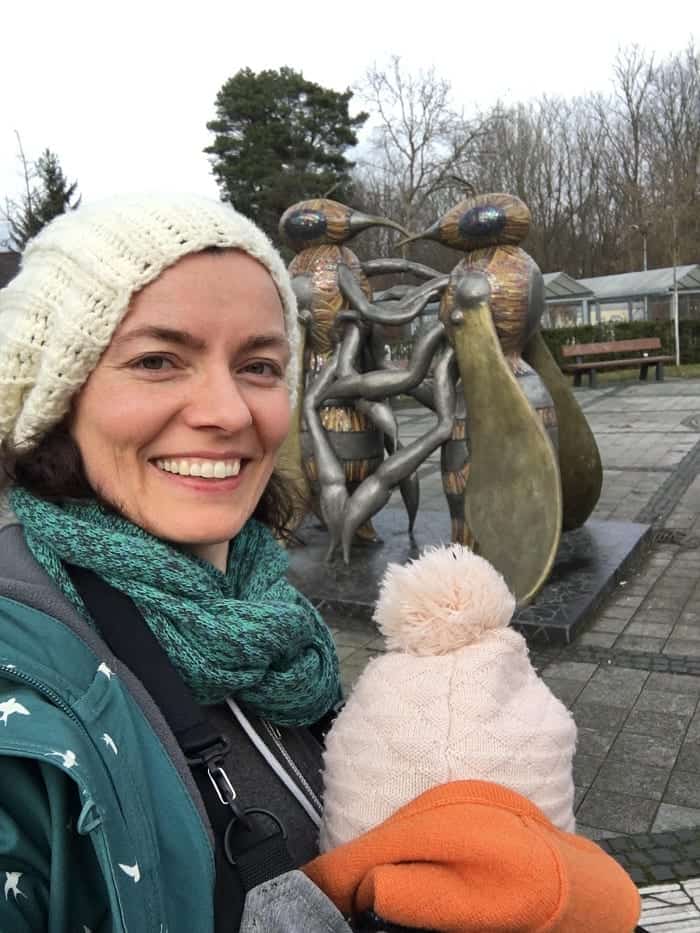Berlin’s most beautiful and most photographed bridge is the two storied Oberbaum Bridge across the Spree. It links two former boroughs that are now one: Friedrichshain in the former East Berlin and Kreuzberg in the former West. Both districts are known for their interesting nightlife. Check out our FREE self-guided Friedrichshain tour and the self-guided Kreuzberg tour.
Take a S-Bahn to the Ostbahnhof or a U-Bahn, Trolley or Bus to the “Warschauer Straße”. Or book one of the sightseeing ships that do the long tour on the river Spree and the Landwehrkanal (a canal south of the river). The Oberbaum Bridge will be the last bridge before the ship enters the canal.
The Oberbaum Bridge has two towers, an elevated subway/underground line on the upper story and a pedestrian walk that has a cloister vault like in the Middle Ages. But why all this effort for this very bridge and how old is it anyway?
Well, the Oberbaum Bridge that you see today isn’t actually as old as it looks. The towers and many other aspects are reconstructions of the 1990s. The bridge was damaged in the Second World War and partly blasted by the German troops on Hitler’s command. The original bridge was built between 1894 and 1986 in the Gothic Revival style and in 1902 the subway/underground rails were ready. The “number one” line is the oldest line in Berlin and connects Friedrichshain and Kreuzberg with the City West at the Kurfürstendamm. In Kreuzberg it’s elevated and gives you some sightseeing possibilities.
The beautiful Oberbaum Bridge replaces an older wooden construction from the early 18th century. Back then; the bridge was part of the excise wall that surrounded the city. Ships had to stop, declare their goods and pay customs. The counterpart was the “Unterbaum Bridge”, now “Crown Prince’s Bridge” near the Central Station (Hauptbahnhof) and the parliament buildings.
So yes, the name of the Oberbaum Bridge (in German: Upper tree bridge) stems from this 18th century tree-barrier that blocked the river especially during nighttime to prevent ships passing by without paying a tariff to the municipality.
The new bridge of the late 19th century was designed to symbolize the function of a city gate that the older bridge had. The two towers are modeled after towers in the town walls of Prenzlau and Kyritz (small towns East of Berlin) and are decorated with a bear (for Berlin) and an Eagle (for the state of Brandenburg). Old coats of arms of surrounding towns decorate the bridge.
After the war, the bridge found itself connecting Friedrichshain (Soviet Sector) with Kreuzberg (American Sector). The East Berlin authorities repaired it, but didn’t rebuild the towers and rather demolished them. In 1948, during the Berlin Blockade, the Oberbaum Bridge was the site of intense smuggling. During an incident with a smuggler, an East Berlin police officer was shot; he is now seen as the first victim of the East West conflict in Berlin. In the mid 1950s, the Eastern authorities decided that only pedestrians could use the bridge. When the Berlin Wall was built in 1961, the Oberbaum Bridge was closes completely until it was reopened for pedestrians in 1972 due to the Four Power Agreement on Berlin.
Today, the Oberbaum Bridge is open to all traffic. The vaults of the pedestrian way are a perfect concert hall for street musicians and sometimes also sites of political demonstration, or legendary events like the Friedrichshain-Kreuzberg Food Fight that took place in the years 1998-2013. People from the two city districts Friedrichshain and Kreuzberg would meet at the bridge for a legendary food and water battle - mostly won by the Friedrichshain team because of their superior “vegetable artillery”. But in 2014 nobody wanted to organize the event and for 2015 nothing is for sure yet. At the Oberbaum Bridge you are very close to another interesting Berlin only thing to see: The East Side Gallery, murals on a piece of the Berlin Wall.
++Learn more about the Berlin Wall with our self-guided tour.++




